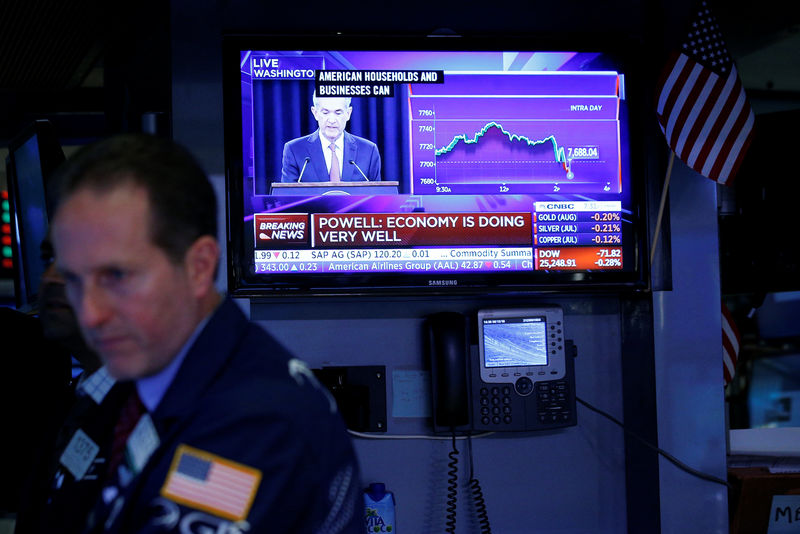By Noreen Burke
Investing.com -- With the Federal Reserve almost certainly set to deliver a half-percentage-point rate hike at its upcoming meeting on Wednesday, investors will be awaiting further insights on its next steps to combat surging inflation. The labor market is another key part of the Fed’s mandate and Friday’s U.S. employment report is expected to show that jobs growth remained robust in April. Earnings will continue to roll in as investors contemplate what was the worst month for stocks in more than two years. Meanwhile, the Bank of England is expected to deliver its fourth rate hike in a row, one day after the Fed, on Thursday. Here’s what you need to know to start your week.
- Fed rate hike
With a half-percentage-point rate hike by the Fed already baked in, investors will be focusing on signals from Fed Chair Jerome Powell at his post-policy meeting press conference on the future path of interest rates, plans for reducing its almost $9 trillion balance sheet and the Fed’s view on when inflation may peak.
Many investors and analysts believe the Fed will continue to surprise on the hawkish side as it attempts to contain the worst inflation in four decades, fueling concerns that aggressive monetary tightening could trigger a recession.
The view of Fed policymakers on how persistent the current pace of inflation is expected to remain will be critical to future monetary policy tightening plans.
“If the Fed continues to expect high levels of inflation and they don’t see it moderating in the future, that will be a concern for investors," Michael Arone, chief investment strategist at State Street Global Advisors, told Reuters.
"It will mean that the Fed will continue to raise rates and tighten monetary policy, which the market is expecting, but maybe even more aggressively."
- Nonfarm payrolls report
Friday’s nonfarm payrolls report is expected to show that the U.S. economy added 380,000 jobs in April, while the unemployment rate is expected to tick down to 3.5%. Average hourly earnings are expected to post another solid increase.
The jobs report comes on the heels of data last Thursday showing that the U.S. economy unexpectedly contracted in the first quarter, but the decline was largely driven by a wider trade deficit as imports surged, and a slowdown in the pace of inventory accumulation. Domestic demand remained robust, allaying fears of a recession.
But the outlook for the economy continues to be clouded by concerns over the economic impact of the war in Ukraine, rising bond yields, new coronavirus lockdowns in China that could stymie improvements in global supply chains, and more aggressive monetary policy tightening by the Fed.
- Earnings reports
Earnings season is set to continue with investors watching reports from Pfizer (NYSE:PFE), Starbucks (NASDAQ:SBUX), Airbnb Inc (NASDAQ:ABNB), and ConocoPhillips (NYSE:COP) during the week, among others.
The month of April marked the S&P 500's biggest monthly fall since the onset of the coronavirus pandemic in early 2020, while the tech-heavy Nasdaq logged its largest monthly drop since the 2008 financial crisis.
Downbeat results and worries about aggressive monetary policy tightening by the Fed hammered mega-cap technology and growth stocks.
The selloff accelerated on Friday as the S&P 500 tumbled 3.6% -- its biggest one-day drop since June 2020 -- following a disappointing earnings and guidance from Amazon (NASDAQ:AMZN) that sent the e-commerce giant's shares down 14%.
- Economic data
Aside from the Fed meeting, earnings and the April jobs report, the economic calendar features several key economic reports in the coming week, including the ISM manufacturing and services PMIs on Monday and Wednesday, respectively. Solid readings here would likely underline the view that the economy will expand in the second quarter, keeping Fed tightening plans on track.
The report on JOLTS jobs openings is due on Tuesday, followed a day later by the ADP nonfarm payrolls figures. The Labor Department is to publish the weekly report on initial jobless claims on Thursday ahead of Friday’s nonfarm payrolls data.
- Bank of England meeting
The Bank of England is widely expected to deliver its fourth straight rate hike when it meets a day after the Fed on Thursday, the first time it would have done that since 1997.
BoE Governor Andrew Bailey has said the bank is treading a "very tight line" between curbing inflation, which at 7% is more than three times its target, and avoiding a recession.
A quarter-point hike to 1% would meet a precondition for the BoE to start actively selling bonds it holds.
Active bond sales would tighten monetary conditions but could hurt a faltering economy and no major central bank has yet started the process.
--Reuters contributed to this report
